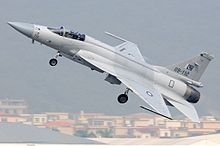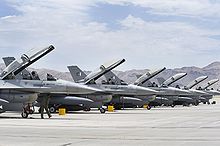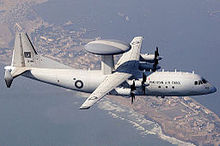Current inventory
The PAF operates approximately 450 combat aircraft of 4 types, which are planned to be reduced to 2 multirole types, namely the F-16 and JF-17, by 2025. There are around 20 front-line squadrons.[74]
The most capable fighter in PAF service from 1983 to 2007 has been the F-16 Fighting Falcon. 40 of the F-16A/B Block 15 models were delivered from 1983 to 1987. Deliveries of another 28 F-16A/B were stopped after the 1990 arms embargo imposed on Pakistan under the Pressler amendment but 14 of these were later delivered during 2005–2008. The F-16A/B fleet is to be upgraded with MLU (Mid-Life Update) modification kits and Falcon Star Structural Service Life Enhancement kits by Turkish Aerospace Industries starting in September 2010 at a rate of 1 per month. Four F-16A/B are already undergoing upgrade in the U.S. for delivery in 2011. The MLU package will include new APG-69v9 radars, Joint Helmet Mounted Cueing Systems and Link-16 data-links, along with other new communications, targeting and electronic warfare systems.[75][76]
In 2006, 12 F-16C and 6 F-16D Block 52+ were ordered with a further 18 aircraft optional. 14 of the optional fighters were ordered in 2010.[77][78] The first batch of 3 F-16C/D fighters landed at PAF Base Shahbaz, Jacacobad, on 26 June 2010.[79][80]Pakistan also received 14 used F-16s from the US free of cost.[81]
The PAF is to induct a number of the Chinese Chengdu FC-20, an advanced PAF-specific variant of the Chengdu J-10. 36 fighters equipping two FC-20 squadrons are expected to be delivered by 2015[82] and, according to some reports, the FC-20 fleet may eventually be increased to 150 fighters.[83] In September 2015, talks between Russia and Pakistan began on the delivery of the Sukhoi Su-35 air-superiority multi-role fighter.[84]
Special mission aircraft
Airborne early warning and control (AEW&C) aircraft were first sought by the PAF in the 1980s, but the requirement was not met until December 2009 when the first of four Saab 2000 Erieye aircraft ordered in 2006 was delivered. The remaining three Erieye are expected to be delivered in 2010. Built to the PAF's specifications, the Saab 2000 Erieye is fitted with 5 operator stations and 4 command stations. The aircraft's Erieye radar has a range of 450 km and is also capable of identifying the type of aircraft and the weapons it is carrying.[85]
Four Chinese ZDK-03 AEW&C aircraft have also been ordered, with first delivery expected in late 2010.[86] These are believed to be a PAF-specific version of the KJ-200, incorporating a Chinese AESA radar similar to the Erieye mounted on the Shaanxi Y-8F600 transport aircraft.
Transport aircraft
The C-130 Hercules has been the PAF's primary tactical transport aircraft since its induction in the early 1960s. Currently 5 C-130B and 11 C-130E[87] models are in service, upgraded with Allison T56-A-15 turboprops and extended fatigue lives by Lockheed-Georgia Company.[88] The C-130 is supplemented by 4 CASA/IPTN CN-235 STOL transports, although the fourth aircraft is equipped with an interior for transporting VIPs such as the PAF Chief of Air Staff. Heavy-lift transports comprise 3 Boeing 707s transferred from Pakistan International Airlines starting 1986.
Aerial refueling aircraft
In December 2009 the PAF received its first of four Il-78 aircraft which is capable of aerial refuelling as well as transporting cargo. Aerial refuelling capability was first demonstrated during the High Mark 2010 exercise on 6 April 2010 when two of the PAF's Mirage III fighters were simultaneously refuelled in the air by the Il-78.[85][89][90][91][92]
Air defence systems
Crotale is expected to be replaced by Spada 2000.[93]
- MBDA Spada 2000 – A low to medium altitude air defence system consisting of a radar with 60 km range and four 6-cell missile launchers. The Aspide 2000 missile can intercept enemy missiles and aircraft at a range of over 20 km. A contract for 10 batteries was signed after Spada 2000 was selected over competing systems from Raytheon, Diehl BGTand Saab AB and pre-contract firing tests in Pakistan, which were assisted by the Italian Air Force.[94] Latest reports state Pakistan is to test the Spada 2000 air defence system in July 2010, followed by deliveries of first of ten batteries. Deliveries of all 10 batteries are reported to be completed by 2013 with further orders possible.[95] Pakistan test fired the new SPADA 2000 Plus air defence missile system in July 2010. The missile system was tested by the Range & Instrumentation Division of SUPARCO (National Space Agency). Three drone planes were successfully intercepted and shot down by the SPADA 2000 Plus Missile System.
- HQ-2 – Chinese version of SA-2 Guideline high altitude air defence system, 12 or more batteries procured circa 1970s.[citation needed]
- HQ-9 – In October 2003 it was reported that China had closed a deal with Pakistan to supply an unspecified number of FT-2000 systems, an anti-radiation variant of the HQ-9 long range air defence system,[96] although in March 2009 a report was published stating that Pakistan was not considering importing the missile.[97] It was reported in mid-2008 that Pakistan intended to purchase a high altitude air defence and missile defence system and the FD-2000, another variant of HQ-9, was expected to be chosen.[93][98]
- AML HE 60-20: Recently sighted at PAF Base Nur Khan. Modified Panhard armoured car with a 20mm anti-aircraft cannon. Used for on-base security.[99] At least 5 were originally in service.[100][101]
Drone technology
On 7 September 2015, Pakistan became the ninth nation to develop and use an armed unmanned combat aerial vehicle (drone) named Burraq. Pakistan first started exploring the drone technology when it acquired Falco drones from Selex Galileo of Italy for $40 million in 2008. Since then Pakistan have been developing Falco in Pakistan Aeronautical Complex in collaboration with the Italian firm. The Burraq was developed which was based on the same Falco technology. By March 2015, Pakistan was able to test-fire Burraq armed with an air-to-surface missile named Barq with pin-point precision. Burraq were used majorly during the Operation Zarb-e-Azb.[102]
Modernisation and acquisitions
The modernisation stall ended in April 2006 when the Pakistani cabinet approved the PAF's proposals to procure new aircraft and systems from several sources, including modern combat aircraft from the U.S. and China. The AFFDP 2019 (Armed Forces Development Programme 2019) would oversee the modernisation of the Pakistan Air Force from 2006 to 2019.[105]
The Bush administration on 24 July 2008 informed the US Congress it plans to shift nearly $230 million of $300 million in aid from counterterrorism programs to upgrading Pakistan's aging F-16s.[106] The Bush administration previously announced on 27 June 2008 it was proposing to sell Pakistan ITT Corporation's electronic warfare gear valued at up to $75 million to enhance Islamabad's existing F-16s.[107] Pakistan has asked about buying as many as 21 AN/ALQ-211(V)9 Advanced Integrated Defensive Electronic Warfare Suite pods, or AIDEWS, and related equipment.[108] The proposed sale will ensure that the existing fleet is "compatible" with new F-16 Block 50/52 fighters being purchased by Islamabad.
After 9/11 the U.S. and Pakistan began discussing the release of the embargoed F-16s and a purchase of new aircraft. Of the 28 F-16A/B built under the Peace Gate III/IV contracts and embargoed in 1990, 14 delivered as EDA (Excess Defense Articles) from 2005 to 2008.,[109] two of which were delivered on 10 July 2007.[110]
Between 2005 and 2008, 14 F-16A/B Block 15 OCU fighters were delivered to the PAF under renewed post-9/11 ties between the U.S. and Pakistan. These had originally been built for Pakistan under the Peace Gate III/IV contracts but were never delivered due to the U.S. arms embargo imposed in 1990.[111]
To upgrade the F-16A/B fleet, 32 Falcon STAR kits were purchased for the original Peace Gate I aircraft and 35 Mid-Life Update (MLU) kits were ordered, with 11 more MLU kits optional, in . 4 F-16A/B being upgraded in the U.S. to F-16AM/BM, delivery expected December 2011.[109] F-16A/B in PAF service to be upgraded starting October 2010 by Turkish Aerospace Industries, 1 per month.[112][113]
The Peace Drive I contract for 12 F-16C and 6 F-16D Block 52+ (Advanced Block 52) aircraft, powered by F100-PW-229engines was signed on 30 September 2006.[114][115] The first F-16 to be completed, an F-16D, was rolled out on 13 October 2009 and began flight testing.[116][117][118][119][120] The first batch of F-16C/D Block 52+, two F-16D and one F-16C, landed at PAF Base Shahbaz, Jacobabad, on 26 June 2010[79][80] and one more F-16C was received by 5 July 2010.[121]
On 13 December 2008, the Government of Pakistan stated that two Indian Air Force aircraft were intercepted by the PAF kilometres within Pakistani airspace. This charge was denied by the Indian government.[122]
During talks with a delegation from the French Senate on Monday 28 September 2009, Prime Minister Yousuf Raza Gilani stated that the PAF had used most of its stockpile of laser-guided munitions against militants in the Malakand and FATA regions and that replacements for such types of equipment were urgently required.[123]
December 2009 saw the delivery of the PAF's first Saab 2000 Erieye AEW&C from Sweden and Il-78MP Midas aerial refuelling tanker/military transport aircraft from Ukraine.[124][125][126]
The PAF is reported to be considering purchasing the Hongdu L-15 advanced jet trainer to train pilots for high-tech fighters such as the FC-20. Extensive evaluations of the aircraft took place in Pakistan during December 2009.[127][128]
On 26 June 2010 the first batch of 3 F-16C/D Block 52+ fighters were delivered to PAF Base Shahbaz, Jacobabad.[129] According to Air Chief Marshal Rao Qamar Suleman (the then Chief of Air Staff) the new fighters would eliminate the PAF's limitations in precision night-time strike operations,[130] the existing capability being based on around 34 Dassault Mirage 5 fighters upgraded with new avionics for night-time precision strike missions under the Retrofit Of Strike Element (ROSE) programme during 1999–2004.[131][132][133] SABIR (Special Airborne Mission Installation & Response System) which is a FLIR System that has Brite Star II and Star Safire III EO/IR sensors installed on the one C130. (this a 'bolt on system' and is installed in place of the parachute door) This system was extensively used during operation in FATA.
Planned acquisitions
Pakistan have been in talks with China to acquire 30 to 40, JF-31 Stealth fighters also known as Shenyang FC-31 or J-31 for short.[134]











